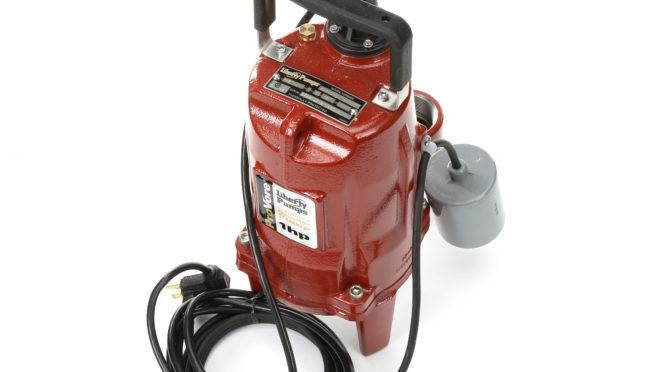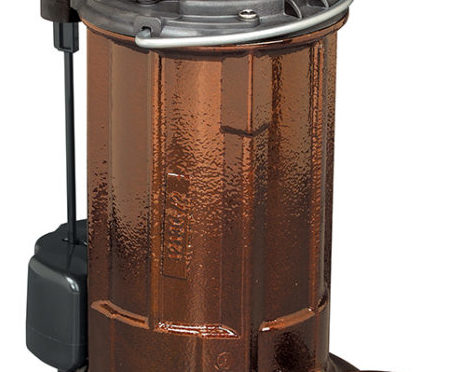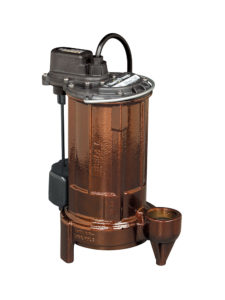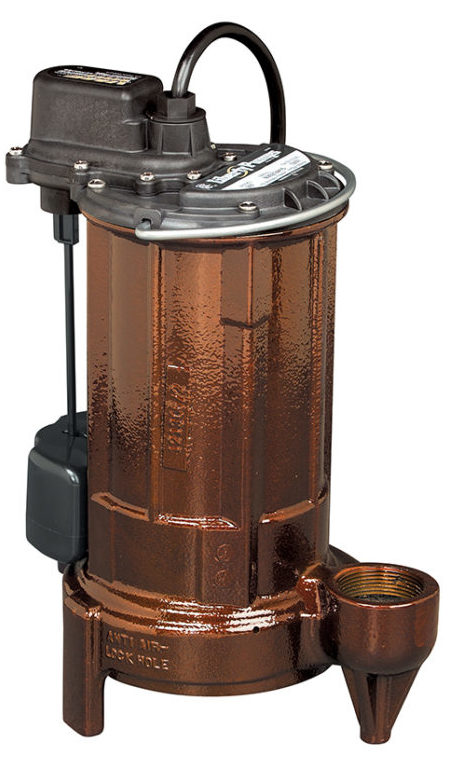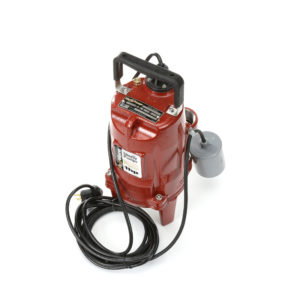 When it comes to sewage pumps, we’ve learned from experience that you can either pay less and pay often (while cleaning up mess after mess along the way) or pay more and buy lasting peace of mind. We’ve spent enough time knee deep in sewage to prefer the latter option to the former, which is why we typically use and recommend sewage grinder pumps for residential and commercial-grade sewage applications.
When it comes to sewage pumps, we’ve learned from experience that you can either pay less and pay often (while cleaning up mess after mess along the way) or pay more and buy lasting peace of mind. We’ve spent enough time knee deep in sewage to prefer the latter option to the former, which is why we typically use and recommend sewage grinder pumps for residential and commercial-grade sewage applications.
Do you absolutely need a sewage grinder pump for your home, rental, or small business? No. There are a number of quality sewage ejector pumps (e.g., the Liberty Pumps LE51A or the Zoeller M267) that will handle 2 inch solids while delivering years of reliability. But if you need pumps capable of shredding difficult solids like feminine hygiene products, towels, baby wipes, and rags and don’t want to put your home or business at risk of an expensive and ill-timed plumbing emergency, you don’t want to leave your toilets at the mercy of a normal sewage ejector pump. You need a sewage grinder pump. If you’re reading this, you already know such things shouldn’t be flushed down drains, but a good grinder pump will help you prepare for people who flush these things anyway.
Today we’re going to look at the Liberty Pumps PRG101A ProVore PRG Series Automatic Residential Grinder Pump. Like the other members of the PRG series (e.g., the PRG102A or the PRG101m or PRG102m), it’s one of the best grinders on the market below $1,000, and we’d trust our home and business on it. Our full review is below, but if you’re ready to buy it, you can buy it here.
Key Features of the Liberty Pumps PRG101A Sewage Grinder Pump (60 Second Summary)
 The Liberty Pumps PRG101A is an automatic submersible residential sewage grinder pump that can also be used in most applications that call for a standard sewage ejector pump. It includes a 1 hp electric motor, a 2,760 gallon per hour maximum flow rate, a max head of 50 feet, and a 3 year warranty. The PRG101A is 11 inches wide, 17-5/8 inches tall, and 7-1/8 inches deep. It weighs 58 pounds.
The Liberty Pumps PRG101A is an automatic submersible residential sewage grinder pump that can also be used in most applications that call for a standard sewage ejector pump. It includes a 1 hp electric motor, a 2,760 gallon per hour maximum flow rate, a max head of 50 feet, and a 3 year warranty. The PRG101A is 11 inches wide, 17-5/8 inches tall, and 7-1/8 inches deep. It weighs 58 pounds.
The PRG101A is housed in class 30 cast iron and includes a class 25 cast iron impeller and a 440 stainless steel cutter and cutter plate. Its motor is oil-filled, thermally protected, runs on 115 volts single phase at 60 Hz AC and draws 12 amps at full load; locked rotor amp draw is 47.5 and thermal overload occurs at 221F. The default configuration includes a 10-foot quick-disconnect power cord; an identical model, the PRG101A-2, can be purchased with a 25-foot power word. The maximum liquid temperature is 140F. It includes an automatic mechanical wide angle float switch and a piggyback plug. The discharge is 2 inch NPT.
While the max pumping rate is 2,760 GPH at zero feet, this rate drops to 2,610 GPH at 10 feet, 2,220 GPH at 20 feet, 1,680 GPH at 30 feet, 960 GPH at 40 feet, and max head and shut-off occurs at 50 feet.
How Does the Liberty Pumps PRG101A Compare to the Liberty Pumps LE51A and Zoeller M267 Sewer Ejector Pumps?
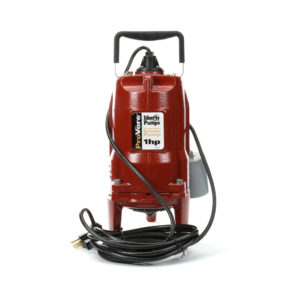 Liberty Pumps specifically states the PRG101A can be used to replace 2 inch discharge systems where both LE50- and LE40-series solids-handling pumps are present, although they add the disclaimer of consulting with their factory regarding specific application and head needs. Practically speaking, the PRG101A will be able to do anything the LE50- or LE40-series pumps can do; despite having a much slower maximum flow rate (e.g., 46 gallons per minute vs 160 gallons per minute), it can pump water much farther and to much greater heights (e.g., 50 feet vs 24 feet), and backs up the additional power with a grinder for processing a range of difficult solids likely to jam sewer ejector (solids-handling) pumps like the LE51A- and LE41A-type pumps.
Liberty Pumps specifically states the PRG101A can be used to replace 2 inch discharge systems where both LE50- and LE40-series solids-handling pumps are present, although they add the disclaimer of consulting with their factory regarding specific application and head needs. Practically speaking, the PRG101A will be able to do anything the LE50- or LE40-series pumps can do; despite having a much slower maximum flow rate (e.g., 46 gallons per minute vs 160 gallons per minute), it can pump water much farther and to much greater heights (e.g., 50 feet vs 24 feet), and backs up the additional power with a grinder for processing a range of difficult solids likely to jam sewer ejector (solids-handling) pumps like the LE51A- and LE41A-type pumps.
Similarly, the PRG101A will be able to process everything the Zoeller M267 can while exceeding it dramatically by being able to shred a range of materials that would stop an M267, including entire towels, sanitary wipes and napkins, diapers, rags, and similar trash inappropriately flushed instead of thrown into the garbage.
Our Short and Long Term Experiences Installing and Using the Liberty Pumps PRG101A Grinder Pump
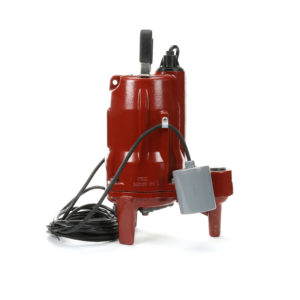 We’re not going to tell you installing a grinder pump is easy; in fact, it’s quite a bit tougher than installing a sump pump. It’s not because of anything related to the pump; it all has to do with where you install it (beneath your house or commercial building), in addition to the fact that you’re working with sewage instead of simply with water. We’d recommend buying a good wet / dry vacuum to help with the inevitable messes if you’re going to install this on your own, and you’ll of course want to have a good amount of experience or someone who does at your side. It’s a fair estimate that you’re going to need at least a full day (a weekend will be better) if performing a standard sewage pump installation. If you’re using it as a replacement sump pump, of course, it’ll only take a few hours.
We’re not going to tell you installing a grinder pump is easy; in fact, it’s quite a bit tougher than installing a sump pump. It’s not because of anything related to the pump; it all has to do with where you install it (beneath your house or commercial building), in addition to the fact that you’re working with sewage instead of simply with water. We’d recommend buying a good wet / dry vacuum to help with the inevitable messes if you’re going to install this on your own, and you’ll of course want to have a good amount of experience or someone who does at your side. It’s a fair estimate that you’re going to need at least a full day (a weekend will be better) if performing a standard sewage pump installation. If you’re using it as a replacement sump pump, of course, it’ll only take a few hours.
We rarely come across dissatisfied owners of the PRG101A. The most satisfied residential and commercial owners are those who have either dealt with failing sewage pumps or who were preemptive and installed it to head off future disasters. It’s important to note that, as is the case with all sewage grinder pumps, it’s designed for high pressure and low volume. It’s not going to be nearly as fast as even a mid-range sewage ejector pump; what it will do is pump much higher and much farther at greater pressure. For example, a typical installation of pushing sewage uphill by 30 feet and horizontally by 200 feet won’t give this pump any trouble, while many sewage ejector pumps would give out long before that in both height and distance.
Once your installation is complete, you can expect somewhere between 15 and 25 years of trouble-free functioning in most cases, although we’ve heard of sporadic cases of failure here and there. When such cases have occurred, they’ve always been well within the warranty period, which is a relief. Overall, such issues should be few and far between.
Troubleshooting and Installation Tips to Get Your Liberty Pumps PRG101A Working Sooner
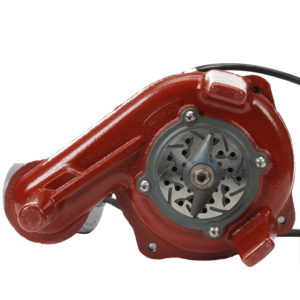 If you’re installing the PRG101A on your own as a DIY sewage pump project, bless you for your patience. Remember to buy as many accessories ahead of time as possible. Similarly, take your time and measure twice in order to cut once. You’re going to need PVC pipe, threaded adapters, additional tubing and coupling adapters, and PVC pipe. It’s better to have these things close at hand in case you break or strip a part while you’re working; you’re not going to want to stop when you’re knee deep in a project like this. Similarly, remember to buy enough PVC cement and that it sets very, very quickly.
If you’re installing the PRG101A on your own as a DIY sewage pump project, bless you for your patience. Remember to buy as many accessories ahead of time as possible. Similarly, take your time and measure twice in order to cut once. You’re going to need PVC pipe, threaded adapters, additional tubing and coupling adapters, and PVC pipe. It’s better to have these things close at hand in case you break or strip a part while you’re working; you’re not going to want to stop when you’re knee deep in a project like this. Similarly, remember to buy enough PVC cement and that it sets very, very quickly.
Once you set up the float switch, make sure it has no obstructions throughout its range of motion; the last thing you want to deal with is a stuck switch (open or closed; both are bad) once you’ve cemented and shut everything several hours later. In general, you’ll also want to make sure both the pump and your float switch are fully functional before you caulk and bolt everything down. You might not want to take the time to start and stop your water and look for leaks and proper water flow throughout the house or building (this includes all sinks, showers, and toilets), but if you don’t do so in the middle of the job, there’s a chance you’ll regret it the moment you think you’re done.
As noted above, don’t forget both a wet-dry vacuum (we like the Craftsman XSP) and a good 2 inch check valve. You’ll also want to measure your check valve’s positioning and make sure you do your fitting while it’s dry and before cementing anything. It sounds obvious, but four hours into a job, nothing will be obvious.
Liberty Pumps PRG101A Pump Pros, Cons, and Value Comparison
In conclusion, there’s no question that you’re going to need to spend more money on a sewer grinder pump like the PRG101A than you would on a sewer ejector pump like the LE51A or M267. On the face of it, such an investment might seem hard to justify, especially if you only focus on the top speeds of sewage clearance. But you don’t buy a sewer grinder pump for speed; you buy it because it’s not going to stop working the first (or second, or third) time someone flushes a hygiene product or cleaning accessory down the toilet. You buy a pump like the PRG101A because you’ve got a business to run and don’t have time to call or play plumber multiple times a year, or because you’re a busy landlord and don’t want to spend what’s left on your free time dealing with clogged toilets, or simply because you’re a homeowner who doesn’t ever want to deal with replacing a sewage pump ever again. If these kinds of scenarios describe you, a grinder pump will pay for itself very quickly, in money and time saved and in peace of mind gained.
You can buy the Liberty Pumps PRG101A here on Amazon. You can buy it with a 25-foot power cord as the PRG101A-2 here. You can buy the Liberty Pumps LE51A here. You can buy the Liberty Pumps LE41A here. You can buy the Zoeller M267 here. You can buy a good wet / dry vacuum here. You can buy a silent 2 inch check valve here.
If you find our work at PumpThatSump helpful, you can support our relentless reviewing of every sump pump on the market by shopping via our Amazon link for whatever you need to make your house a home. Despite being self-employed, we promise not to spend it all on health insurance.
